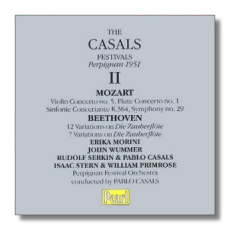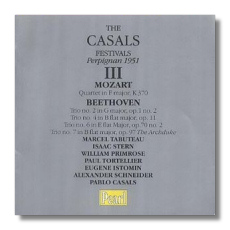
The Internet's Premier Classical Music Source
Related Links
- Latest Reviews
- More Reviews
-
By Composer
-
Collections
DVD & Blu-ray
Books
Concert Reviews
Articles/Interviews
Software
Audio
Search Amazon
Recommended Links
Site News
 CD Review
CD Review
The Casals Festivals – Perpignan 1951

Volume II
- Wolfgang Mozart:
- Violin Concerto #5 "Turkish", K. 219
- Flute Concerto #1, K. 313
- Sinfonia Concertante in E Flat Major, K. 364
- Symphony #29 in A Major, K. 201
- Ludwig van Beethoven:
- Variations on "Ein Mädchen, Oder Weibchen", Op. 66
- Variations on "Bei Mannern" from Mozart's Die Zauberflöte"
Erica Morini, violin
Isaac Stern, violin
John Wummer, flute
William Primrose, viola
Pablo Casals, cello
Rudolf Serkin, piano
Perpignan Festival Orchestra/Pablo Casals
Pearl GEMS0168 ADD monaural 2CDs: 70:53, 73:11


Volume III
- Wolfgang Mozart: Quartet in F Major, K. 370
- Ludwig van Beethoven:
- Piano Trio #2 in E Major, Op. 1 #2
- Piano Trio #4 in B Flat Major, Op. 11
- Piano Trio #6 in E Flat Major, Op. 70 #2
- Piano Trio #7 "Archduke" in B Flat Major, Op. 97
Isaac Stern, violin
Alexander Schneider, violin
William Primrose, viola
Pablo Casals, cello
Paul Tortelier, cello
Marcel Tabuteau, oboe
Eugene Istomin, piano
Pearl GEMS0174 ADD monaural 2CDs: 75:16, 74:08
Many incredible musicians considered it an honor to work with Pablo Casals, even if it meant momentarily putting their solo careers aside and sitting in an orchestra like a member of the rank and file, relatively speaking. Was it because Casals was such a great conductor, or, in terms of technique, such a master of his instrument? No, and Casals was a musician, of course, but he also was a humanist, and his humanism suffused everything that he did, including music-making. The fate of mankind was uppermost in his mind at all times, and he even silenced his cello for a time to protest the failure of the "civilized" world to respond to human rights abuses in his Spanish homeland. Fortunately for us, in time he was convinced to play again, and the Casals Festivals were a large part of that story. Violinist Alexander Schneider (of the Budapest Quartet) induced him to take the central role in a 1950 Bach Festival in the Catalan village of Prades, in honor of the two-hundredth anniversary of the composer's death. This festival was succeeded by the 1951 Casals Festival in Perpignan – the material preserved here – and there was a Casals Festival in Puerto Rico too. (Later, Casals would take part in the Marlboro Festivals in Vermont, but that's a different story.)
Volume II is dominated by Casals the conductor. He compensated for his lack of "stick technique" with his demand for exhaustive rehearsals. Casals didn't lead the orchestral musicians as much as he taught them. He educated them about the music and about the nuances that made it come alive – articulation, phrasing, and the expressive manipulation of tone, to name three. At least at Perpignan, his tempos tended to be on the slow side. The tempos themselves didn't make the musicianship profound, although they certainly helped. Here, the best of the three concertos is the Sinfonia concertante with young Isaac Stern and the more veteran William Primrose. Both were at the peak of their powers, and this performance could hardly be more fulfilling and divine. Morini, a cult violinist, seems a bit off her best in the "Turkish" Concerto, and Wummer's version of the Flute Concerto is a little too rich for my tastes. The two sets of Beethoven variations go very well, as Serkin spurs Casals on.
Volume III is devoted to four of Beethoven's piano trios (Istomin, Schneider, and Casals) and to Mozart's Oboe Quartet (Tabuteau, Stern, Primrose, and Tortelier). Again, Casals the cellist is that much more compelling when he has a young heart beating beside him – Istomin was only in his mid-twenties during this Festival. The music-making is almost regal in its bearing, and one could argue that this is somewhat missing the point, where Beethoven is concerned. Certainly, one needs to go to Panenka, Suk, and Chuchro (for example) to find more idiomatic playing, but the present line-up plays as if they wish to transcend time and space.
Producer Roger Beardsley includes a brief note in the booklet in which he makes few excuses for the sound quality. "These are wonderfully vivid recordings made at live performances," he writes. "Any faults that cannot be corrected are minor." I don't agree. I've heard many 1930s-vintage 78s that sounded better than this. The chief problem here is the high level of distortion. It is particularly damaging to the piano, whose tone is made to curdle at anything louder than a mezzo forte, but it affects all of the instruments. I don't know the cause of the problem, but it sounds a lot like the result of using a dull stylus to play an LP. It is a shame that this fault gets in the way of the music. Not strictly a technical problem, Casals's moans and grunts (the auditory equivalent of the grimaces to which cellists seem to be especially prone) have the potential to become an irritant, over time.
These are absolutely "classic" readings, but I don't think I could recommend them to everyone without qualification. If it's the music you want, there are some safer alternatives. If you're interested in the Casals legend, and in divining the difference between personality and ego, then go for it.
Copyright © 2002, Raymond Tuttle


















